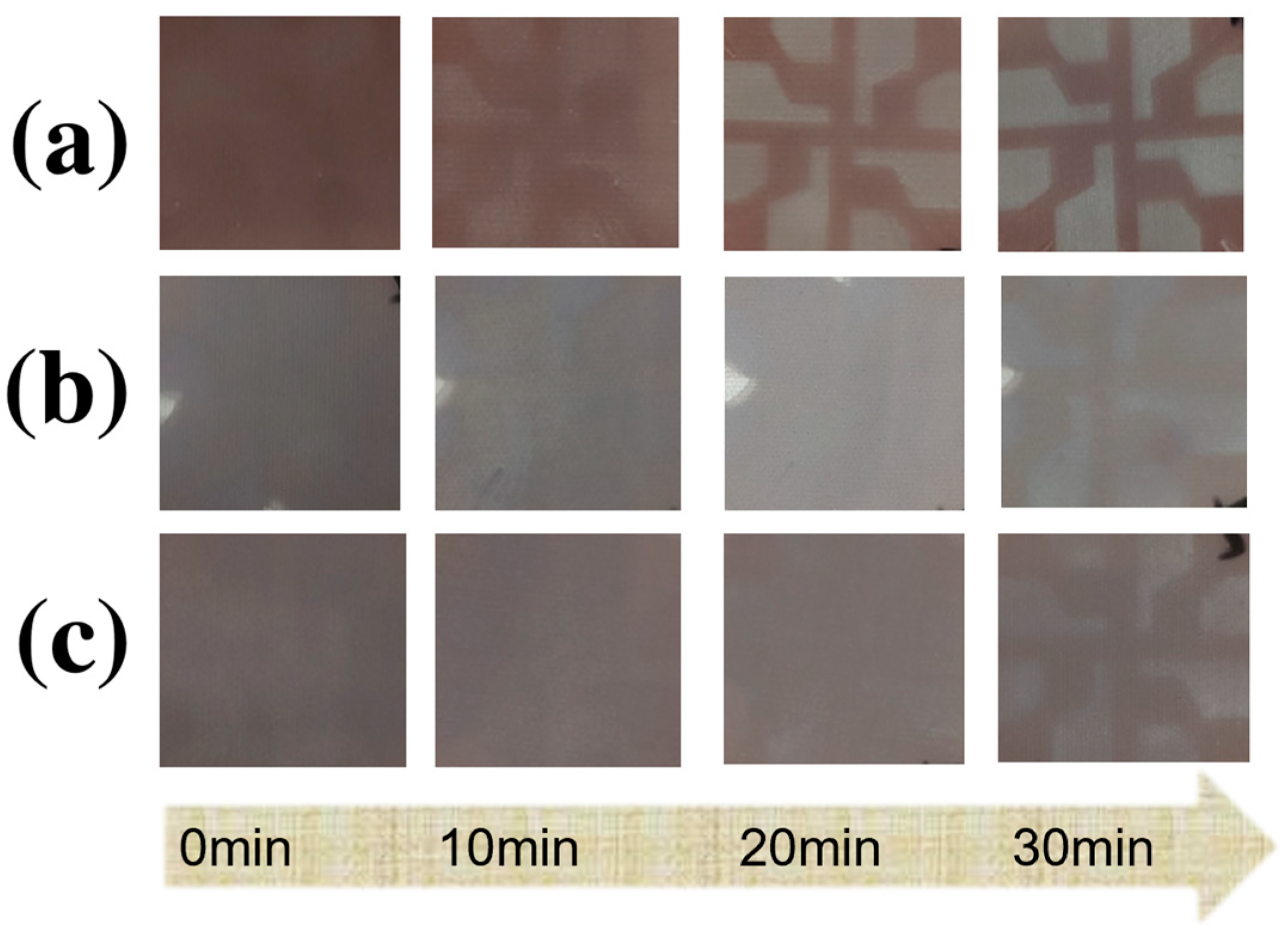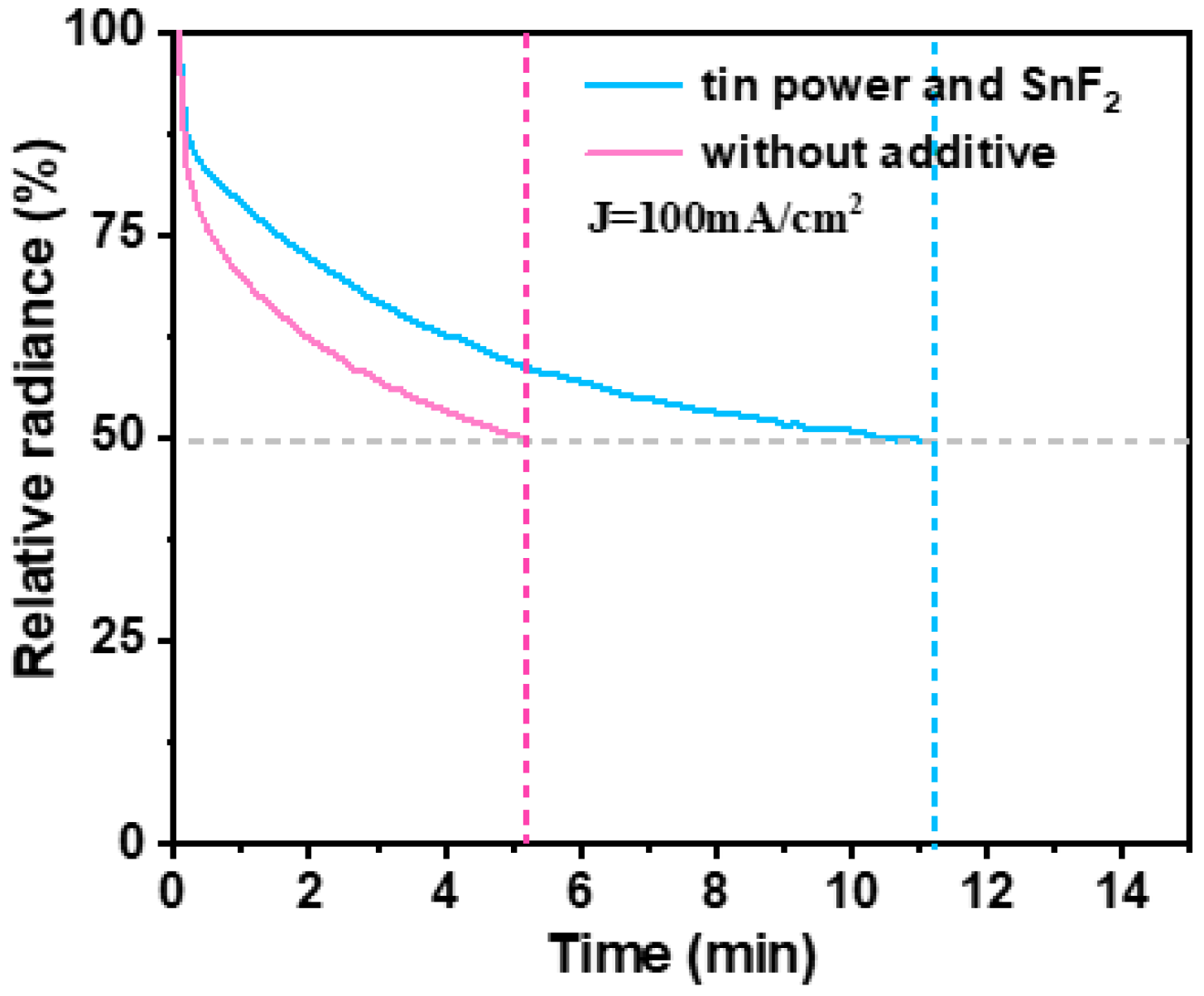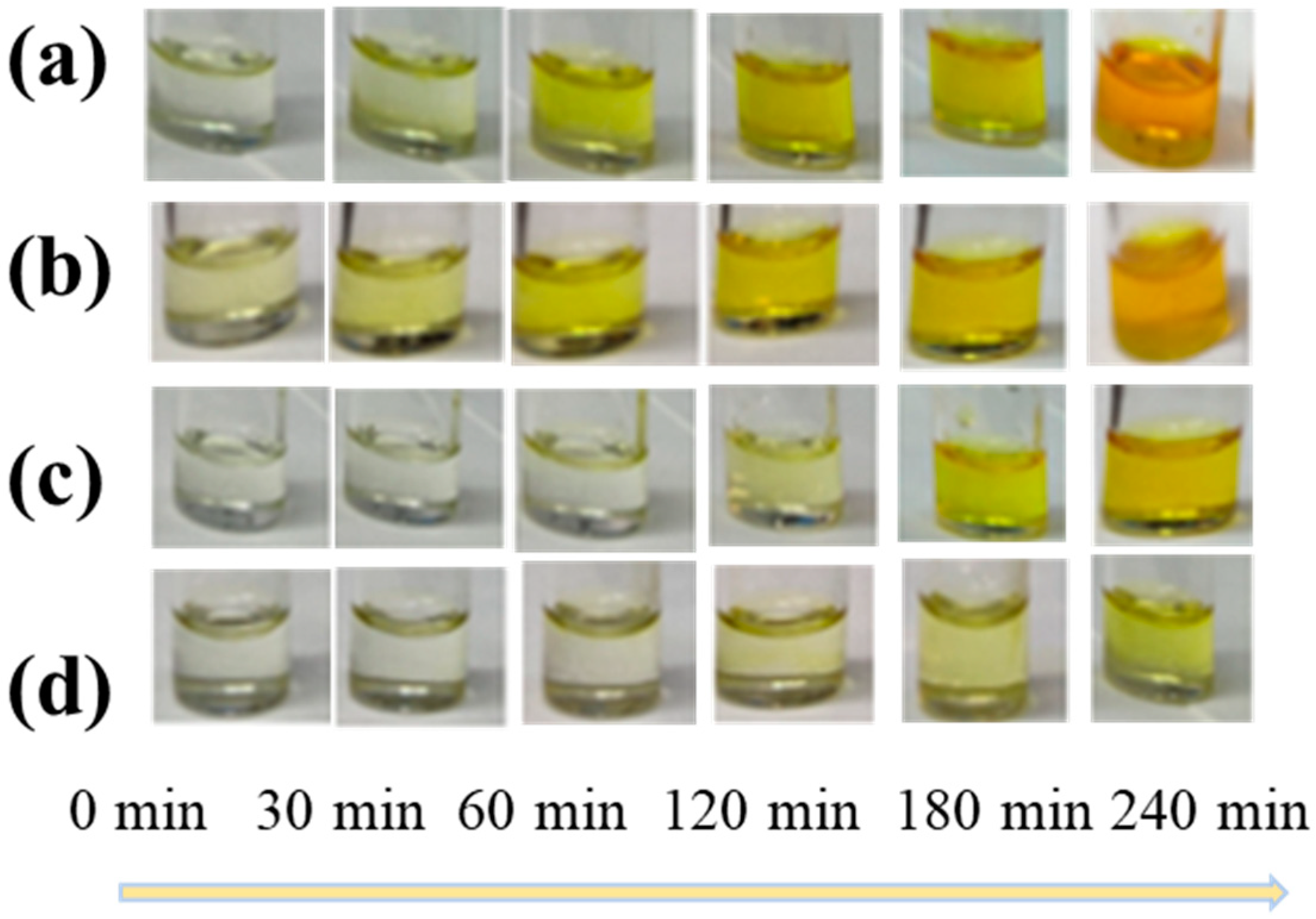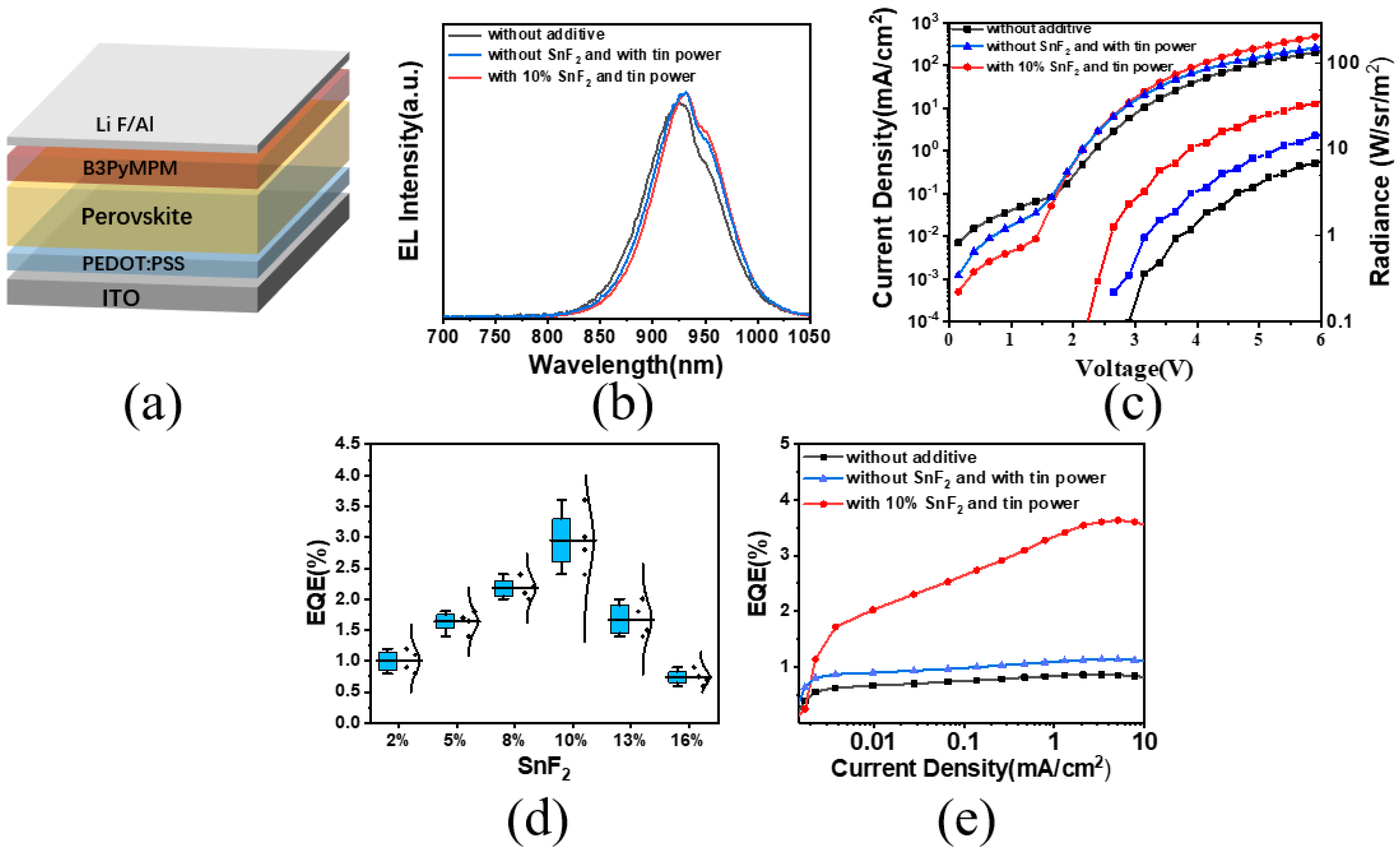Improving the Antioxidant Properties of Tin-Based Perovskite for the Enhanced Performance of Near-Infrared Light-Emitting Diodes Through the Synergy of Sn and SnF2
Abstract
:1. Introduction
2. Materials and Methods
2.1. Material
2.2. Preparation of Precursor Solution
2.3. Device Fabrication
2.4. Film Characterization
3. Results and Discussion
3.1. Environmental Stability of Perovskite Precursor Solution
3.2. Analysis of Antioxidant Capacity of Tin-Based Perovskite Films
3.3. Crystallography and Optical Properties of Tin-Based Perovskite Films
3.4. Electrical Capability Analysis of Tin-Based Perovskite Devices
4. Conclusions
Author Contributions
Funding
Institutional Review Board Statement
Informed Consent Statement
Data Availability Statement
Conflicts of Interest
Appendix A




References
- Zhu, L.; Cao, H.; Xue, C.; Zhang, H.; Qin, M.; Wang, J.; Wen, K.; Fu, Z.; Jiang, T.; Xu, L.; et al. Unveiling the additive-assisted oriented growth of perovskite crystallite for high performance light-emitting diodes. Nat. Commun. 2021, 12, 5081. [Google Scholar] [CrossRef] [PubMed]
- Cao, Y.; Wang, N.; Tian, H.; Guo, J.; Wei, Y.; Chen, H.; Miao, Y.; Zou, W.; Pan, K.; He, Y.; et al. Perovskite light-emitting diodes based on spontaneously formed submicrometre-scale structures. Nature 2018, 562, 249–253. [Google Scholar] [CrossRef] [PubMed]
- Kojima, A.; Teshima, K.; Shirai, Y.; Miyasaka, T. Organometal Halide Perovskites as Visible-Light Sensitizers for Photovoltaic Cells. J. Am. Chem. Soc. 2009, 131, 6050–6051. [Google Scholar] [CrossRef] [PubMed]
- Cho, H.; Jeong, S.H.; Park, M.H.; Kim, Y.H.; Wolf, C.; Lee, C.L.; Heo, J.H.; Sadhanala, A.; Myoung, N.; Yoo, S.; et al. Overcoming the electroluminescence efficiency limitations of perovskite light-emitting diodes. Science 2015, 350, 1222–1225. [Google Scholar] [CrossRef] [PubMed]
- Wang, N.; Cheng, L.; Ge, R.; Zhang, S.; Miao, Y.; Zou, W.; Yi, C.; Sun, Y.; Cao, Y.; Yang, R.; et al. Perovskite light-emitting diodes based on solution-processed self-organized multiple quantum wells. Nat. Photonics 2016, 10, 699–704. [Google Scholar] [CrossRef]
- Yuan, M.; Quan, L.N.; Comin, R.; Walters, G.; Sabatini, R.; Voznyy, O.; Hoogland, S.; Zhao, Y.; Beauregard, E.M.; Kanjanaboos, P.; et al. Perovskite energy funnels for efficient light-emitting diodes. Nat. Nanotechnol. 2016, 11, 872–877. [Google Scholar] [CrossRef]
- Stoumpos, C.C.; Frazer, L.; Clark, D.J.; Kim, Y.S.; Rhim, S.H.; Freeman, A.J.; Ketterson, J.B.; Jang, J.I.; Kanatzidis, M.G. Hybrid Germanium Iodide Perovskite Semiconductors:Active Lone Pairs, Structural Distortions, Direct and Indirect Energy Gaps and Strong Nonlinear Optical Properties. J. Am. Chem. Soc. 2015, 137, 6804–6819. [Google Scholar] [CrossRef]
- Lai, M.L.; Tay, T.Y.S.; Sadhanala, A.; Dutton, S.E.; Li, G.; Friend, R.H.; Tan, Z.-K. Tunable Near-Infrared Luminescence in Tin Halide Perovskite Devices. J. Phys. Chem. Lett. 2016, 7, 2653–2658. [Google Scholar] [CrossRef]
- Hong, W.-L.; Huang, Y.-C.; Chang, C.-Y.; Zhang, Z.-C.; Tsai, H.-R.; Chang, N.-Y.; Chao, Y.-C. Efficient Low-Temperature Solution-Processed Lead-Free Perovskite Infrared Light-Emitting Diodes. Adv. Mater. 2016, 28, 8029–8036. [Google Scholar] [CrossRef]
- Konstantakou, M.; Stergiopoulos, T. A critical review on tin halide perovskite solar cells. J. Mater. Chem. A 2017, 5, 11518–11549. [Google Scholar] [CrossRef]
- Chowdhury, T.H.; Reo, Y.; Yusoff, A.R.B.M.; Noh, Y.Y. Sn-Based Perovskite Halides for Electronic Devices. Adv. Sci. 2022, 9, 2203749. [Google Scholar] [CrossRef] [PubMed]
- Saidaminov, M.I.; Spanopoulos, I.; Abed, J.; Ke, W.; Wicks, J.; Kanatzidis, M.G.; Sargent, E.H. Conventional Solvent Oxidizes Sn(II) in Perovskite Inks. ACS Energy Lett. 2020, 5, 1153–1155. [Google Scholar] [CrossRef]
- Yang, X.; Ji, Y.; Li, Q.; Zhong, Q.; Li, H.; Lu, Z.; Chen, H.H.; Wang, Y.; Hu, A.; Li, S.; et al. Group-VA Doped ZnO Injection Layer for Bright and Efficient Perovskite Light-Emitting Diodes. Adv. Funct. Mater. 2024, 2413517. [Google Scholar] [CrossRef]
- Ji, Y.; Zhong, Q.; Yu, M.; Yan, H.; Li, L.; Li, Q.; Xu, H.; Li, S.; Chen, P.; Zhao, L.; et al. Amphoteric Chelating Ultrasmall Colloids for FAPbI3 Nanodomains Enable Efficient Near-Infrared Light-Emitting Diodes. ACS Nano 2024, 18, 8157–8167. [Google Scholar] [CrossRef]
- Song, T.B.; Yokoyama, T.; Stoumpos, C.C.; Logsdon, J.; Cao, D.H.; Wasielewski, M.R.; Aramaki, S.; Kanatzidis, M.G. Importance of Reducing Vapor Atmosphere in the Fabrication of Sn-based Perovskite Solar Cells. J. Am. Chem. Soc 2016, 139, 836–842. [Google Scholar] [CrossRef]
- Lee, S.J.; Shin, S.S.; Kim, Y.C.; Kim, D.; Ahn, T.K.; Noh, J.H.; Seo, J.; Seok, S.I. Fabrication of Efficient Formamidinium Tin Iodide Perovskite Solar Cells through SnF2–Pyrazine Complex. J. Am. Chem. Soc. 2016, 138, 3974–3977. [Google Scholar] [CrossRef]
- Liang, H.; Yuan, F.; Johnston, A.; Gao, C.; Choubisa, H.; Gao, Y.; Wang, Y.K.; Sagar, L.K.; Sun, B.; Li, P.; et al. High Color Purity Lead-Free Perovskite Light-Emitting Diodes via Sn Stabilization. Adv. Sci. 2020, 7, 1903213. [Google Scholar] [CrossRef]
- Gu, F.; Ye, S.; Zhao, Z.; Rao, H.; Liu, Z.; Bian, Z.; Huang, C. Improving Performance of Lead-Free Formamidinium Tin Triiodide Perovskite Solar Cells by Tin Source Purification. Sol. RRL 2018, 2, 1800136. [Google Scholar] [CrossRef]
- Xu, P.; Chen, S.; Xiang, H.-J.; Gong, X.-G.; Wei, S.-H. Influence of Defects and Synthesis Conditions on the Photovoltaic Performance of Perovskite Semiconductor CsSnI3. Chem. Mater. 2014, 26, 6068–6072. [Google Scholar] [CrossRef]
- Kontos, A.G.; Kaltzoglou, A.; Siranidi, E.; Palles, D.; Angeli, G.K.; Arfanis, M.K.; Psycharis, V.; Raptis, Y.S.; Kamitsos, E.I.; Trikalitis, P.N.; et al. Structural Stability, Vibrational Properties, and Photoluminescence in CsSnI3 Perovskite upon the Addition of SnF2. Inorg. Chem. 2016, 56, 84–91. [Google Scholar] [CrossRef]
- Pascual, J.; Flatken, M.; Félix, R.; Li, G.; Turren-Cruz, S.H.; Aldamasy, M.H.; Hartmann, C.; Li, M.; Di Girolamo, D.; Nasti, G.; et al. Fluoride Chemistry in Tin Halide Perovskites. Angew. Chem. Int. Ed. 2021, 60, 21583–21591. [Google Scholar] [CrossRef] [PubMed]
- Min, H.; Chang, J.; Tong, Y.; Wang, J.; Zhang, F.; Feng, Z.; Bi, X.; Chen, N.; Kuang, Z.; Wang, S.; et al. Additive treatment yields high-performance lead-free perovskite light-emitting diodes. Nat. Photonics 2023, 17, 755–760. [Google Scholar] [CrossRef]
- Heo, J.-M.; Cho, H.; Lee, S.-C.; Park, M.-H.; Kim, J.S.; Kim, H.; Park, J.; Kim, Y.-H.; Yun, H.J.; Yoon, E.; et al. Bright Lead-Free Inorganic CsSnBr3 Perovskite Light-Emitting Diodes. ACS Energy Lett. 2022, 7, 2807–2815. [Google Scholar] [CrossRef]




Disclaimer/Publisher’s Note: The statements, opinions and data contained in all publications are solely those of the individual author(s) and contributor(s) and not of MDPI and/or the editor(s). MDPI and/or the editor(s) disclaim responsibility for any injury to people or property resulting from any ideas, methods, instructions or products referred to in the content. |
© 2024 by the authors. Licensee MDPI, Basel, Switzerland. This article is an open access article distributed under the terms and conditions of the Creative Commons Attribution (CC BY) license (https://creativecommons.org/licenses/by/4.0/).
Share and Cite
Shen, Y.; Chen, J.; Si, Y.; Xiao, Z.; Kang, K.; Tang, Z.; Wang, J.; Xiang, C. Improving the Antioxidant Properties of Tin-Based Perovskite for the Enhanced Performance of Near-Infrared Light-Emitting Diodes Through the Synergy of Sn and SnF2. Materials 2024, 17, 6059. https://doi.org/10.3390/ma17246059
Shen Y, Chen J, Si Y, Xiao Z, Kang K, Tang Z, Wang J, Xiang C. Improving the Antioxidant Properties of Tin-Based Perovskite for the Enhanced Performance of Near-Infrared Light-Emitting Diodes Through the Synergy of Sn and SnF2. Materials. 2024; 17(24):6059. https://doi.org/10.3390/ma17246059
Chicago/Turabian StyleShen, Yipeng, Jianan Chen, Yuhan Si, Zhengguo Xiao, Kai Kang, Zhaobing Tang, Jing Wang, and Chaoyu Xiang. 2024. "Improving the Antioxidant Properties of Tin-Based Perovskite for the Enhanced Performance of Near-Infrared Light-Emitting Diodes Through the Synergy of Sn and SnF2" Materials 17, no. 24: 6059. https://doi.org/10.3390/ma17246059
APA StyleShen, Y., Chen, J., Si, Y., Xiao, Z., Kang, K., Tang, Z., Wang, J., & Xiang, C. (2024). Improving the Antioxidant Properties of Tin-Based Perovskite for the Enhanced Performance of Near-Infrared Light-Emitting Diodes Through the Synergy of Sn and SnF2. Materials, 17(24), 6059. https://doi.org/10.3390/ma17246059






